Medical Tourism Statistics: Medical tourism has emerged as a significant global industry where individuals travel across international borders to seek medical treatment, often for reasons such as cost savings, access to specialized treatments, or shorter wait times.
This phenomenon has gained momentum due to advancements in transportation, communication, and healthcare technologies, making it easier for patients to access medical services in different parts of the world.
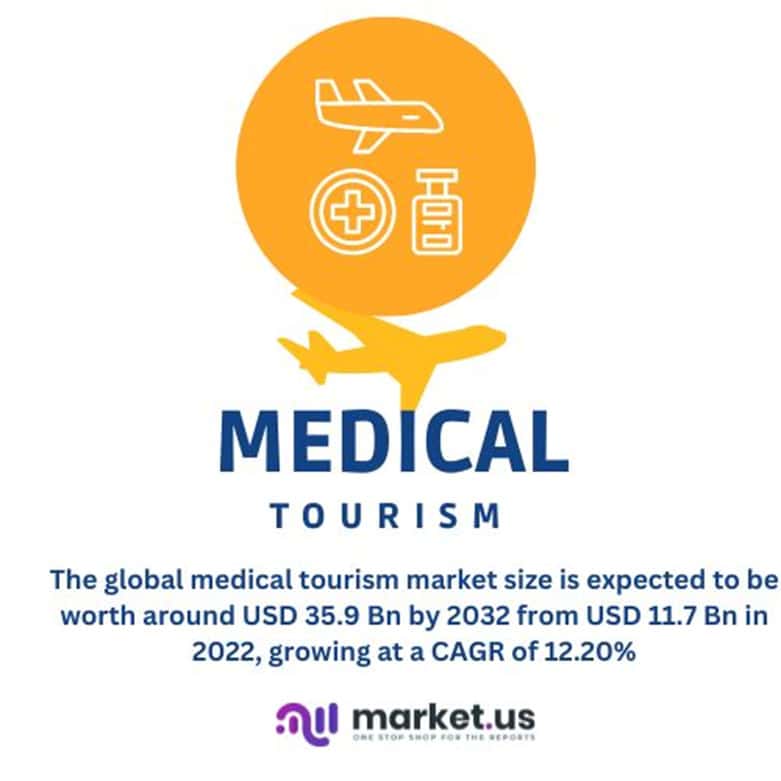
Table of Contents
- Curator’s Choice
- Global Medical Tourism Market Key Statistics
- Reasons – Medical Tourism Statistics
- Top Medical Procedures in Medical Tourism
- Top Medical Tourism Destinations Statistics
- Factors Influencing Medical Tourism Statistics
- Age and Gender Distribution of Medical Tourism Statistics
- Medical Tourism for Cost-Effective Treatments Statistics
- Economic Impact of Medical Tourism Statistics
- Top 5 Key Players in Medical Tourism Market Statistics
- Challenges and Risks – Medical Tourism Statistics
- Recent Developments
- Final Thoughts
- FAQs
Curator’s Choice
- Growth Rate: The medical tourism industry is growing at an estimated rate of 15-25% annually.
- Top Destinations: Popular medical tourism destinations include Thailand, Mexico, India, Turkey, Malaysia, Costa Rica, and Singapore.
- Motivation – Cost: Approximately 40-80% savings on medical procedures motivate patients to seek treatment abroad.
- Common Procedures: The most sought-after medical procedures in medical tourism include cosmetic surgery, dental treatments, orthopedic surgeries, and cardiac procedures.
- Patient Origin: The majority of medical tourists come from the United States, Canada, the United Kingdom, and Western Europe.
- Satisfaction Rate: Over 90% of medical tourists express satisfaction with the quality of care received during their medical journey.
- Economic Impact: The medical tourism industry is estimated to contribute over $100 billion annually to the global economy.
(Source: Patients Beyond Borders, Medical Tourism Association, Deloitte)
Global Medical Tourism Market Key Statistics
- The global medical tourism market size is expected to be worth around USD 35.9 Bn by 2032 from USD 11.7 Bn in 2022, growing at a CAGR of 12.20% during the forecast period from 2022 to 2032.
- The Asia Pacific region is the largest market for medical tourism, accounting for 75% of the global market in 2021.
- Medical tourism can save patients up to 70% on the cost of care compared to the United States.
(Source: Market.us)
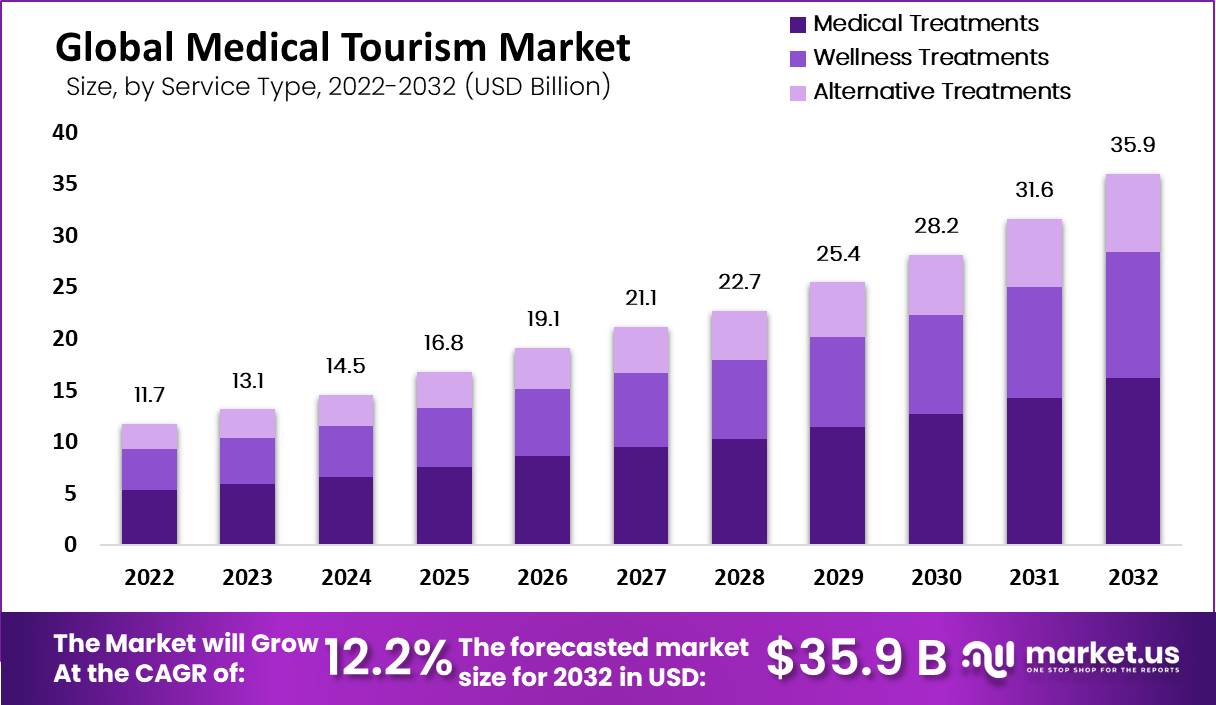
Reasons – Medical Tourism Statistics
- Cost Savings: The primary reason for medical tourism is cost savings, with procedures often costing 30-80% less than in the patient’s home country.
- Quality of Care: About 50% of medical tourists choose medical tourism destinations due to access to high-quality healthcare services.
- No Insurance Coverage: Around 25% of medical tourists seek treatment abroad because certain procedures aren’t covered by their insurance plans.
- Shorter Wait Times: Long waiting lists in home countries drive 20% of medical tourists to seek faster treatment options abroad.
- Advanced Technology: Approximately 30% of medical tourists travel to access cutting-edge medical technology and treatments.
- Privacy and Confidentiality: About 15% of medical tourists prioritize the privacy and confidentiality offered by healthcare facilities abroad.
- Lack of Local Expertise: Nearly 20% of medical tourists travel because the specific medical expertise they need is unavailable locally.
- Holistic and Alternative Therapies: Around 10% of medical tourists seek alternative therapies and holistic treatments available in certain medical tourism destinations.
- Combining Treatment with Vacation: Approximately 40% of medical tourists view medical travel as an opportunity to combine treatment with leisure and vacation.
- Referrals and Recommendations: Recommendations from friends, family, and medical professionals influence the medical tourism decision of about 25% of patients.
(Source: Deloitte, Patients Beyond Borders, Medical Tourism Association, Harvard Health Publishing, CNBC, Frost & Sullivan)
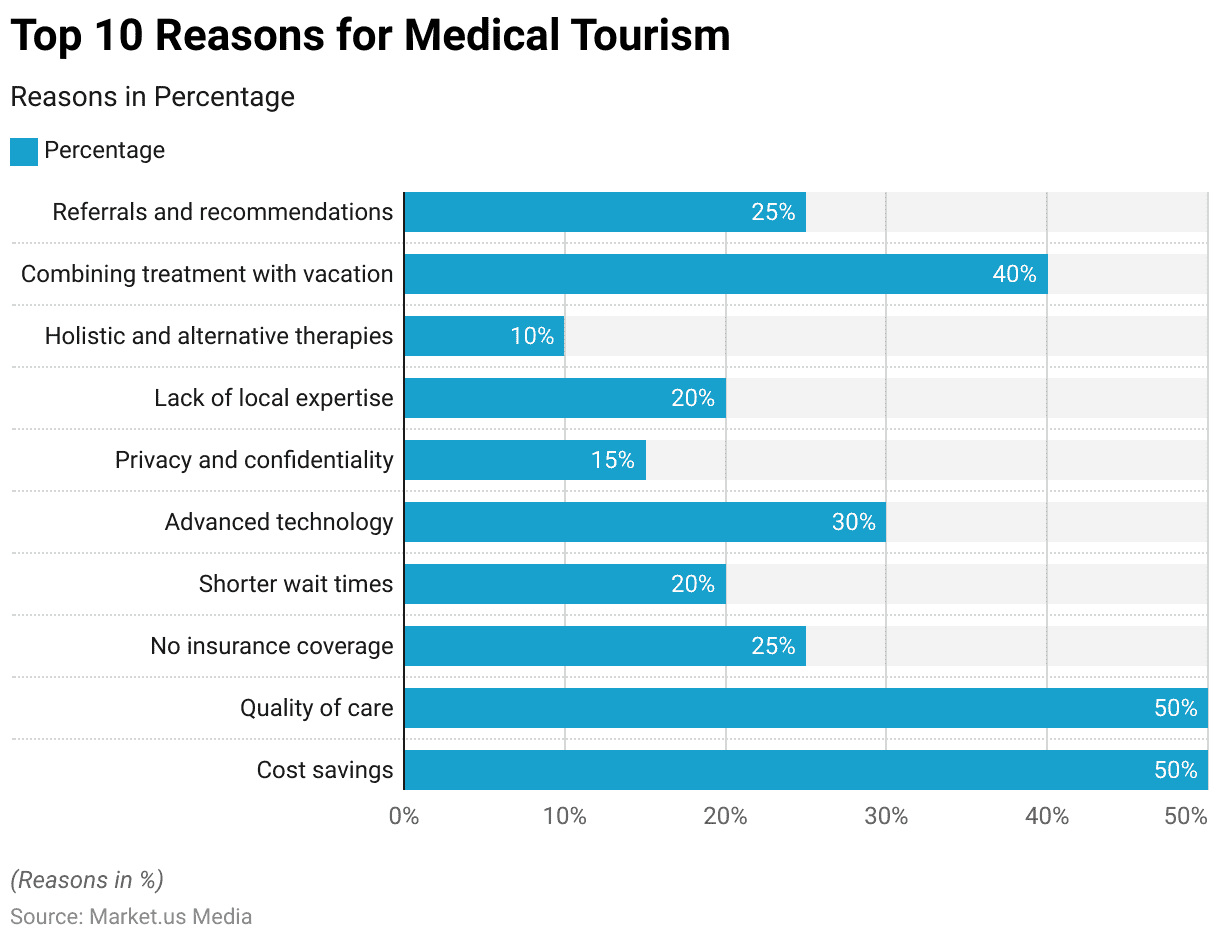
Top Medical Procedures in Medical Tourism
- Cosmetic Surgery: Cosmetic procedures account for approximately 25% of medical tourism, with popular treatments including breast augmentation, liposuction, and facelifts.
- Dental Procedures: Dental treatments make up around 15% of medical tourism, including services like implants, veneers, and teeth whitening.
- Orthopedic Surgeries: Joint replacements and orthopedic procedures constitute about 10% of medical tourism, with significant cost savings compared to many developed countries.
- Cardiac Treatments: Cardiac surgeries, such as bypass surgery and angioplasty, attract patients due to high-quality care at lower costs, making up around 8% of medical tourism.
- Fertility Treatments: Fertility procedures like IVF are sought by couples, contributing to about 12% of medical tourism, often due to availability and affordability.
- Bariatric Surgery: Bariatric surgeries for weight loss account for about 7% of medical tourism, offering specialized treatments and comprehensive care.
- Cancer Treatments: Cancer patients seek advanced treatments abroad, with around 8% of medical tourists receiving various cancer therapies.
- Ophthalmic Procedures: Eye surgeries like LASIK and cataract removal are popular, comprising about 10% of medical tourism, driven by skilled specialists.
- Neurological Treatments: Neurosurgical procedures, including spine surgeries and brain surgeries, attract patients seeking expertise, making up around 6% of medical tourism.
- Gastric Procedures: Gastric bypass and other weight-related surgeries make up about 5% of medical tourism, with specialized facilities catering to these needs.
(Source: Medical Tourism Association, Patients Beyond Borders, McKinsey & Company, International Medical Travel Journal, World Health Organization, Medical Tourism Magazine)
Top Medical Tourism Destinations Statistics
Medical Tourism in India

- The Indian medical tourism market is estimated to be worth $6 billion.
- India receives around 500,000 medical tourists annually, making it a prominent destination.
- Cardiac surgery and orthopedic procedures are some of the most sought-after treatments by medical tourists due to India’s expertise.
- Medical tourists in India can experience savings of 65-90% on medical expenses compared to Western countries.
- The country offers over 20,000 registered medical tourists’ beds across various hospitals, ensuring quality care.
- India’s accredited medical facilities and skilled doctors provide a high level of patient satisfaction.
- The Indian government has taken steps to simplify the medical visa process, enhancing the ease of access for international patients.
(Source: Ministry of Tourism-India, Medical Tourism Association, India Brand Equity Foundation, Deloitte, Ministry of External Affairs-India)
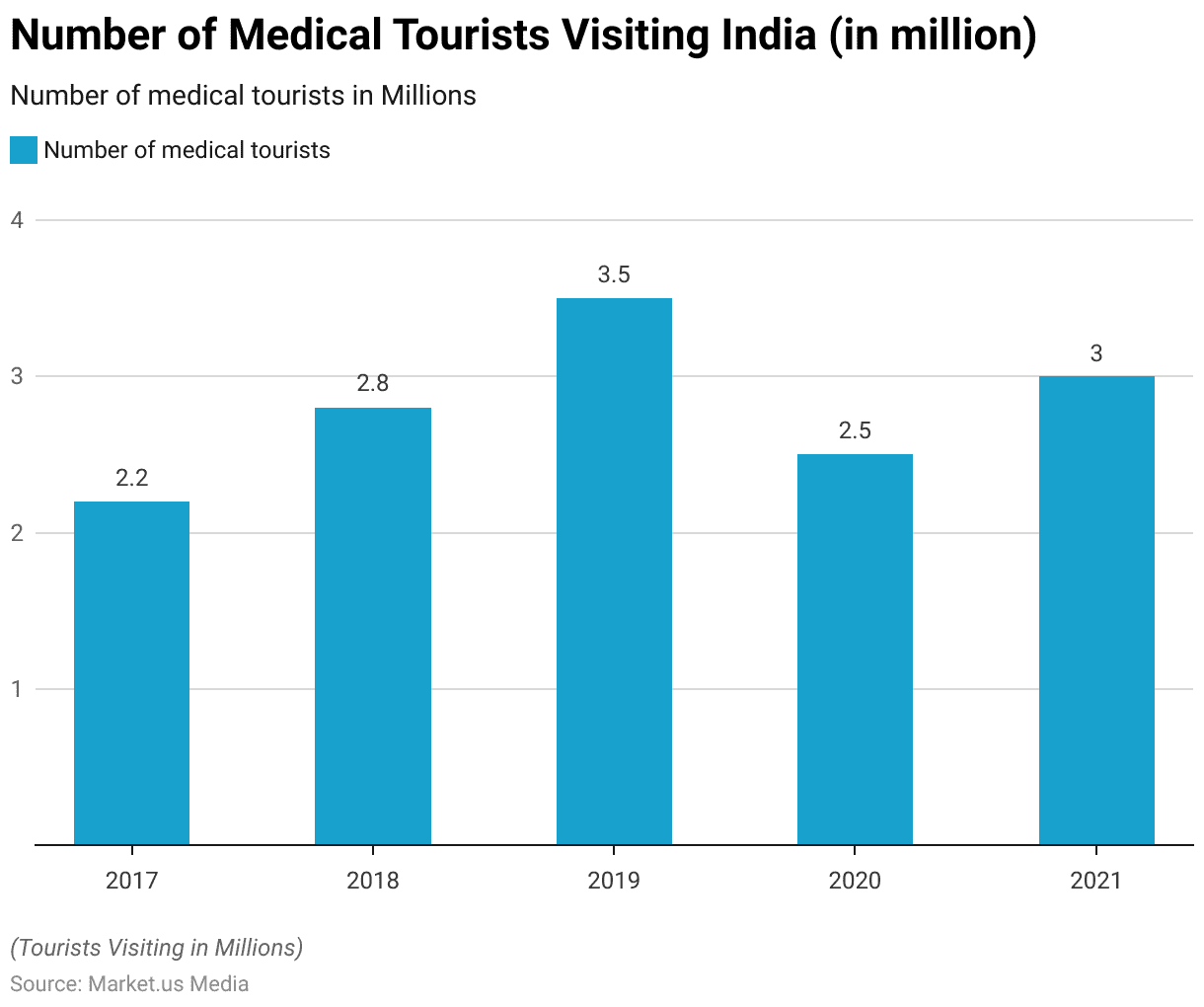
Medical Tourism in Thailand

- The number of medical tourists visiting Thailand has increased by 20% per year in recent years.
- Thailand has over 100 hospitals and clinics that are accredited by the Joint Commission International (JCI).
- Over 2.5 million medical tourists visit Thailand annually for healthcare services.
- Medical treatments in Thailand can cost 30-70% less than in Western countries, attracting budget-conscious patients.
- The value of medical tourism in Thailand amounted to around nine billion U.S. dollars. This was forecast to reach approximately 24.4 billion U.S. dollars in 2027.
- Government policy aims for Thailand to be a ‘Medical and Wellness’ destination and a world-class medical hub.
- In 2017, international patients were forecasted to generate THB 48-49 billion in income for private hospitals, showing a 3%-4% growth from the previous year.
- The number of international patients is projected to increase to 2.4-3.3 million, including medical tourists and expats.
- Medical tourism is expected to support a tourism sector growth of approximately 16% annually during 2017-2020.
- The International Healthcare Research Center (IHRC) predicts a 14% annual growth in medical tourism, aligning with the 12% yearly growth of international tourist arrivals in Thailand.
(Source: Patients Beyond Borders, JCI, Medical Tourism Association, Tourism Authority of Thailand, Statista, KPMG)
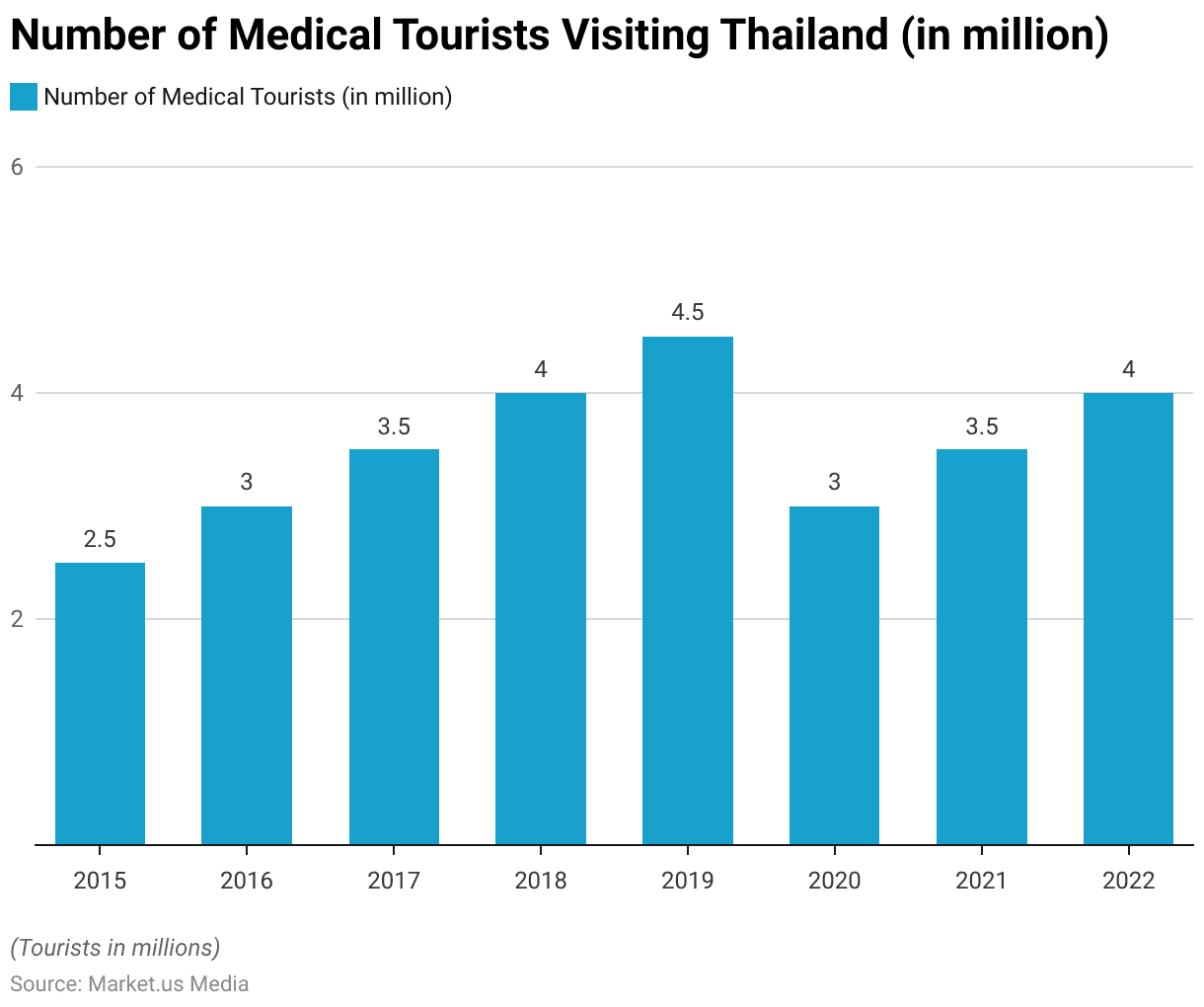
Medical Tourism in Singapore
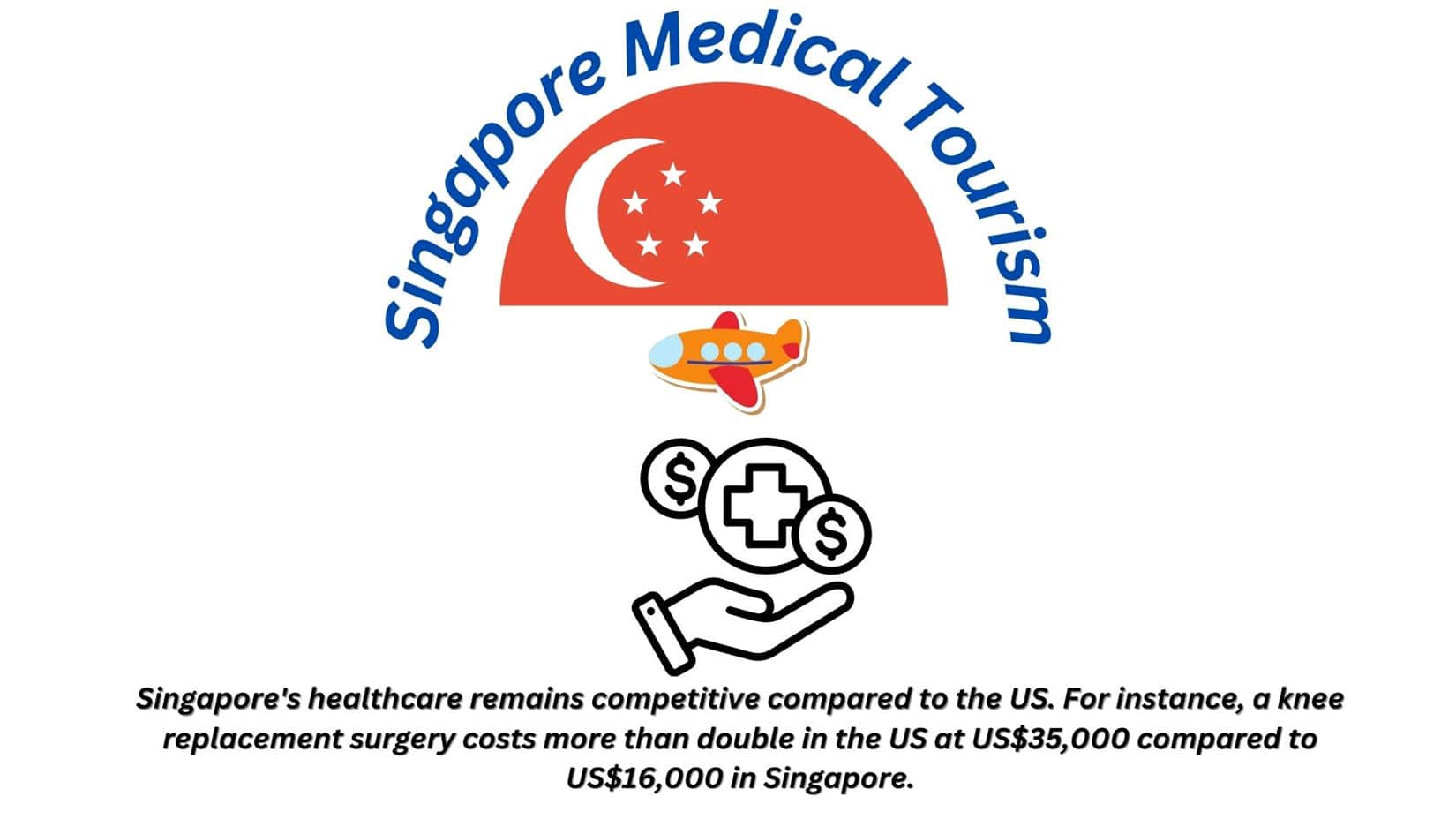
- The average cost of medical care in Singapore is 30-50% lower than in the United States.
- Singapore receives 500,000 medical tourists each year.
- The cost of knee replacement surgery in Singapore is S$22,000, more than double Malaysian prices at S$10,000.
- Singapore’s medical cost inflation was 10% in 2018, 10 times the estimated rate of 1%.
- The cost of medical visits and treatments in Singapore has increased by approximately 9% since 2015.
- Singapore is ranked the most expensive city in the world for the 6th year running.
- Singapore’s healthcare remains competitive compared to the US. For instance, a knee replacement surgery costs more than double in the US at US$35,000 compared to US$16,000 in Singapore.
- More than half of Singapore’s medical tourists are from Indonesia, with approximately 250,000 Indonesians visiting Singapore for medical care each year.
(Source: Medical Tourism Association, budget direct)
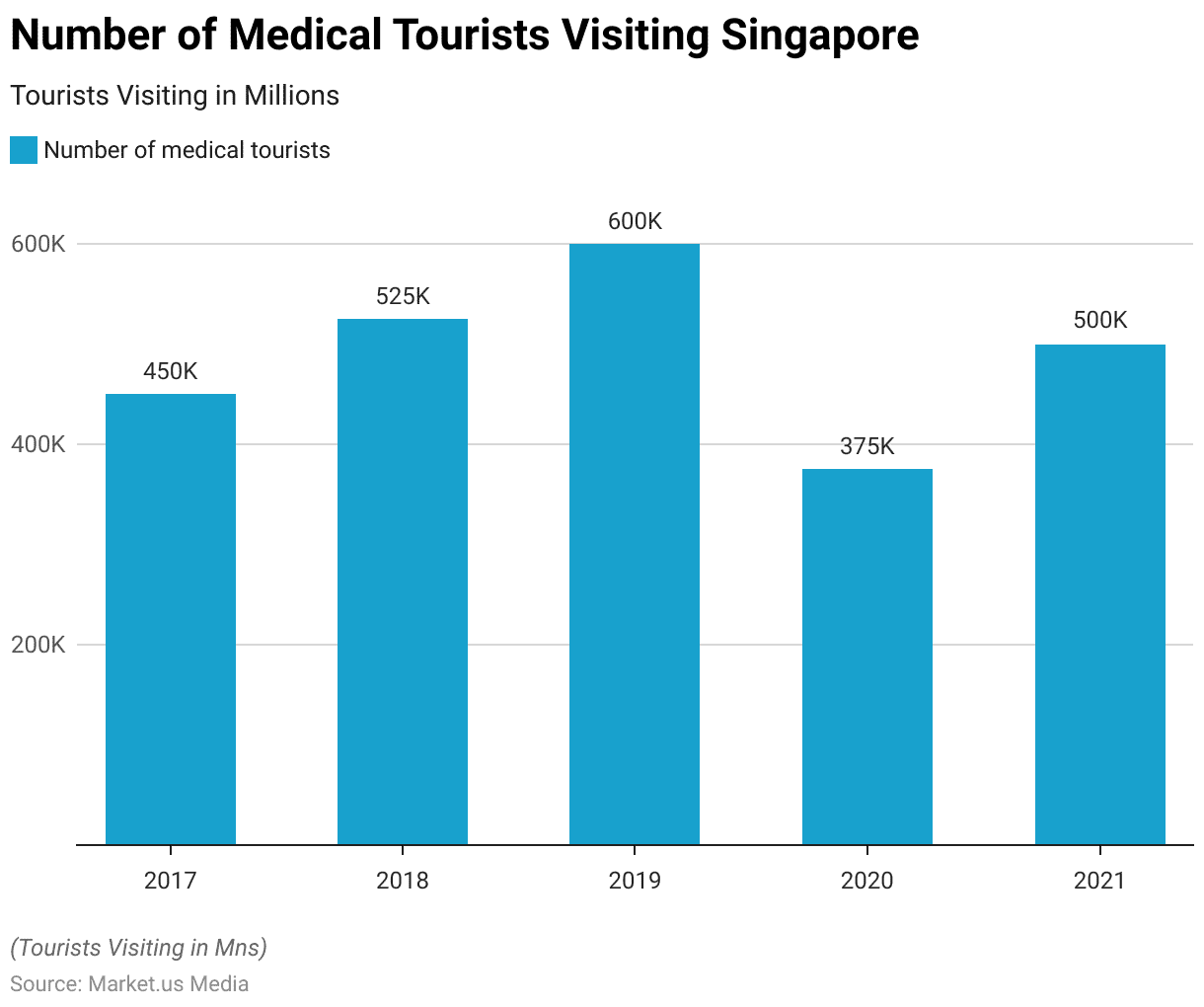
Medical Tourism in Mexico
- The number of medical tourists visiting Mexico has increased by 30% per year in recent years.
- Mexico has over 100 hospitals and clinics that are accredited by the Joint Commission International (JCI).
- The average cost of medical care in Mexico is 40-60% lower than in the United States.
- Mexico attracts more than 1.3 million medical tourists each year.
- Dental and Bariatric procedures offer savings of around 75% compared to costs in the United States.
- Orthopedic treatments provide approximately 70% in cost savings.
- Prescription medication costs can be reduced by 30-60%.
(Source: Patients Beyond Borders, JCI, Medical Tourism Association, medicaltourismco)
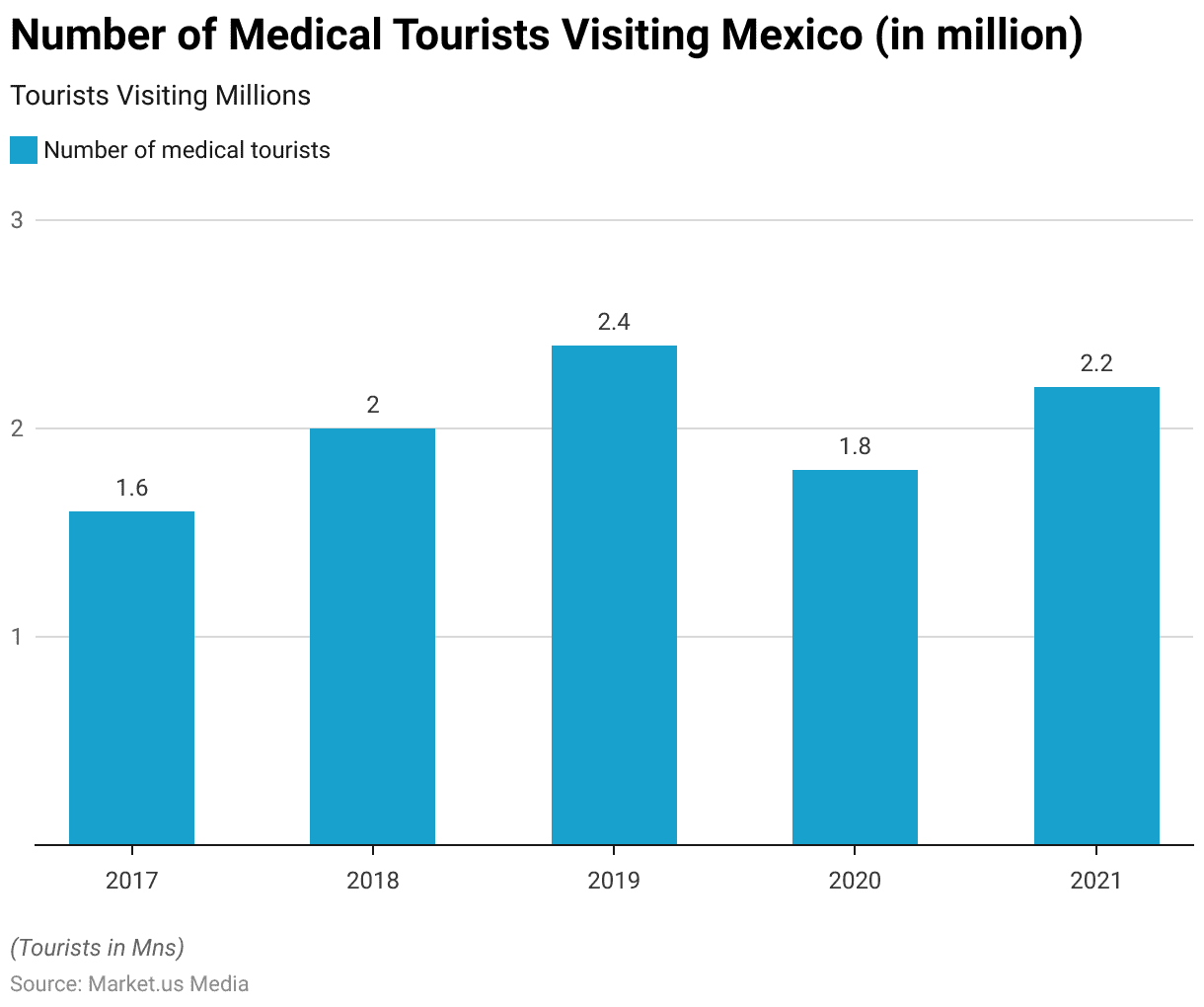
Medical Tourism in Malaysia
- The number of medical tourists visiting Malaysia has increased by 20% per year in recent years.
- The average cost of medical care in Malaysia is 30-60% lower than in the United States.
- Malaysia offers a wide range of medical procedures, including cosmetic surgery, dental surgery, and cardiac care.
- Malaysia receives over 1 million medical tourists annually.
- Malaysia has over 70 JCI-accredited healthcare facilities, ensuring international quality standards.
- The country’s strategic location, modern infrastructure, and English-speaking medical professionals make it an attractive destination.
- Kuala Lumpur, the capital city, is a hub for medical tourism, offering world-class medical services and tourist attractions.
(Source: Patients Beyond Borders, Medical Tourism Association, Medical Travel Today, Malaysia Healthcare Travel Council, Joint Commission International)

Medical Tourism in Turkey

- The average cost of medical care in Turkey is 50-70% lower than in the United States.
- Turkey has a well-trained medical workforce with experience in Western medicine.
- Turkey receives over 700,000 medical tourists annually.
- Istanbul is a prime medical tourism hub, attracting around 40% of the medical tourists in the country.
- The country offers a wide range of medical services, including cosmetic surgeries, dental procedures, and organ transplants.
- Turkey’s healthcare system has been expanding, with more than 50 internationally accredited hospitals.
(Source: Medical Tourism Association, Ministry of Health-Turkey, Istanbul Chamber of Commerce, Turkey Healthcare Tourism)

Medical Tourism in Costa Rica
- Costa Rica receives around 50,000 medical tourists annually, drawn by its medical expertise and natural beauty.
- Dental procedures are a major attraction, with 30% of medical tourists seeking dental care due to quality and cost advantages.
- Cosmetic surgery is another popular choice, accounting for 25% of medical tourism cases, with reputable surgeons and picturesque recovery settings.
- Costa Rica offers savings of up to 45-65% on medical treatments compared to U.S. prices, making it an appealing option.
- The country boasts over 30 internationally accredited medical facilities, ensuring high standards of care and patient safety.
- Costa Rica’s strategic location and well-developed infrastructure contribute to its position as a top medical tourism destination.
(Source: Promed Costa Rica)
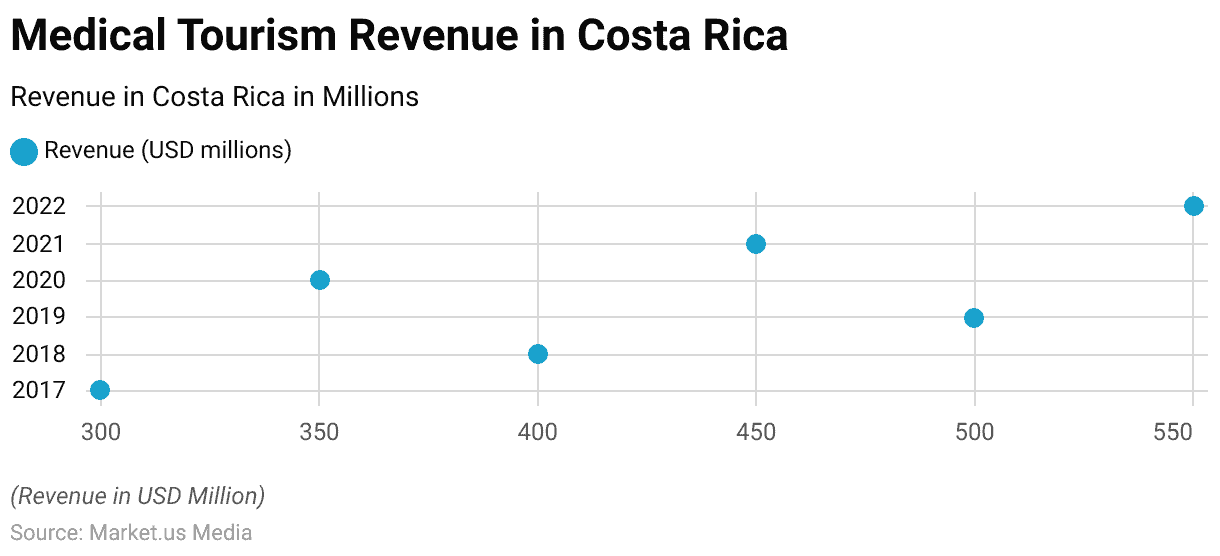
Medical Tourism in the United States
- Around 1.9 million inbound medical tourists annually.
- Top procedures sought include cardiac surgeries, orthopedic procedures, and cancer treatments.
- The U.S. offers cutting-edge technology and world-renowned medical centers.
- Medical tourists cite access to specialized treatments and expert medical opinions as the main reasons for visiting.
- Average cost savings of up to 40-80% for certain procedures compared to other developed countries.
- Major medical hubs like Florida, California, and New York attract a significant number of medical tourists.
(Source: Patients Beyond Borders, Medical Tourism Magazine, U.S. Travel Association, Medical Tourism Association, U.S. News & World Report)

Factors Influencing Medical Tourism Statistics
- Cost Savings: Cost is a major driver for medical tourism. Patients can save up to 80% on medical procedures.
- Quality of Care: Around 45% of medical tourists choose destinations based on the quality of medical care.
- Waiting Times: Over 70% of medical tourists cited long waiting times in their home countries as a reason for seeking treatment abroad.
- Availability of Procedures: Medical tourists often seek procedures that might not be available or approved in their home countries.
- Technological Advancements: About 62% of medical tourists mentioned access to advanced medical technology as a significant factor.
- Language and Cultural Affinity: Ease of communication is crucial, with 87% of patients preferring destinations where they speak the language or share cultural similarities.
- Privacy and Anonymity: Privacy concerns influence about 30% of medical tourists who seek treatment away from their home countries.
- Legal and Regulatory Environment: 49% of medical tourists consider the legal framework of the destination country for medical procedures.
- Tourism Attractions: Tourist attractions in a destination influence about 55% of medical tourists’ choices.
(Source: Patients Beyond Borders, Deloitte, McKinsey & Company, Journal of Travel Medicine, Global Wellness Institute, Medical Tourism Association, Medical Tourism Magazine, International Journal of Environmental Research and Public Health, Deloitte)
Age and Gender Distribution of Medical Tourism Statistics
- Age Distribution: The majority of medical tourists fall within the age range of 40 to 60 years old, comprising around 45% of all medical tourists.
- Gender Breakdown: Women constitute a higher percentage of medical tourists, making up approximately 60% of the total medical tourism population.
- Younger Patients: An emerging trend shows a rise in medical tourists aged 18 to 30, accounting for about 15% of the total medical tourism demographic.
- Elderly Medical Travelers: Patients aged 60 and above make up about 25% of medical tourists, seeking specialized treatments such as joint replacements and cardiac surgeries.
- Gender Preference in Procedures: Women often dominate cosmetic procedures, constituting about 80% of patients, while men tend to seek treatments for cardiology and orthopedics.
(Source: Medical Tourism Association, World Health Organization, Patients Beyond Borders, Deloitte, Journal of Travel Medicine)
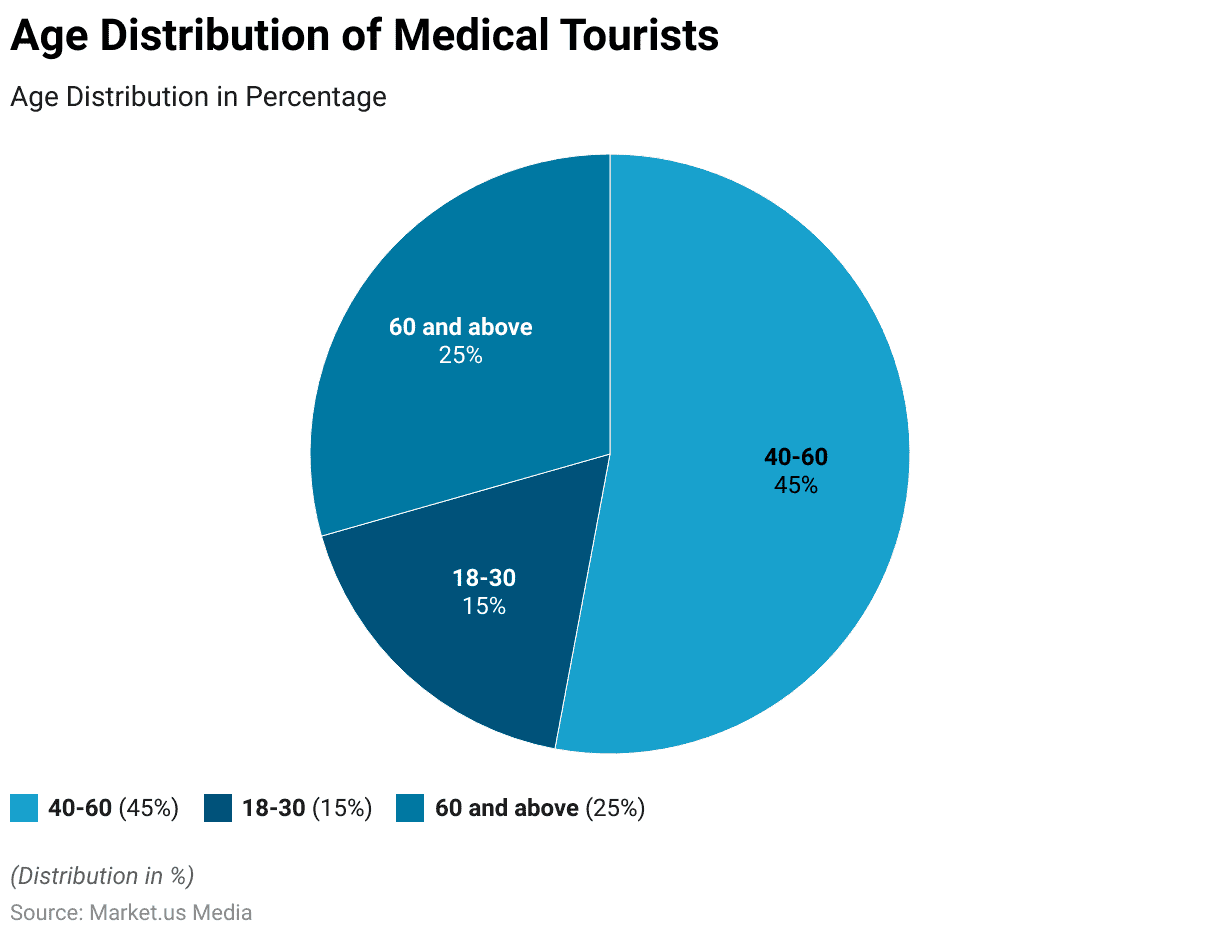
Medical Tourism for Cost-Effective Treatments Statistics
- Medical tourists can save up to 50-80% on healthcare costs by seeking treatments abroad, including travel expenses.
- In the United States, the average cost of a heart bypass surgery is around $123,000, while the same procedure in countries like India or Mexico costs about $10,000-20,000.
- Dental procedures can cost 60-70% less for medical tourists, with a dental implant in the US costing around $3,000-5,000, compared to around $900-1,500 in countries like Thailand or Costa Rica.
- An orthopedic procedure like a knee replacement in the US can cost around $35,000, while the cost in countries like Turkey or Malaysia is about $7,000-10,000.
(Source: Patients Beyond Borders, Medical Tourism Index, Medical Tourism Association)
| Procedure | Cost in the US | Cost in Other Countries | Savings |
| Heart bypass surgery | $123,000 | $10,000-20,000 | up to $103,000 |
| Dental implant | $3,000-5,000 | $900-1,500 | up to $1,500-3,500 |
| Knee replacement | $35,000 | $7,000-10,000 | up to $25,000-25,000 |
Economic Impact of Medical Tourism Statistics
- Medical tourism is estimated to contribute over $100 billion to the global economy annually.
- Popular medical tourism destinations often witness an increase of up to 25% in healthcare-related revenue.
- Employment opportunities in medical tourism-related sectors can grow by 15% in certain regions.
- Infrastructure development in medical tourism hubs can attract investments exceeding $500 million.
- Medical tourism can account for up to 10% of a country’s GDP in certain cases.
(Source: World Tourism Organization, Deloitte, International Society of Travel Medicine, Frost & Sullivan, International Finance Corporation)
Top 5 Key Players in Medical Tourism Market Statistics
Apollo Hospitals
- Apollo Hospitals was founded in 1983, Apollo Hospitals is the largest healthcare provider in India and one of the most popular medical tourism destinations in the world.
- The hospital has over 60 hospitals and 2,500 beds across India.
- It treats over 4 million patients each year, including 200,000 international patients.
- It offers a wide range of medical services, including cardiac surgery, cancer treatment, and orthopedics.
- The hospital is accredited by the Joint Commission International (JCI), the gold standard for international healthcare accreditation.
(Source: Apollo Hospitals, Joint Commission International)
Fortis Healthcare
- Founded in 1996, Fortis Healthcare is another leading healthcare provider in India and a popular medical tourism destination.
- The hospital has over 40 hospitals and 10,000 beds across India.
- It treats over 3 million patients each year, including 100,000 international patients.
- The hospital offers a wide range of medical services, including cosmetic surgery, dental care, and fertility treatment.
- It is accredited by the National Accreditation Board for Hospitals & Healthcare Providers (NABH), the apex body for healthcare accreditation in India.
(Source: Fortis Healthcare, NABH)
Max Healthcare
- Founded in 2000, Max Healthcare is one of the fastest-growing healthcare providers in India and a popular medical tourism destination.
- The hospital has over 30 hospitals and 6,000 beds across India.
- It treats over 2 million patients each year, including 50,000 international patients. The hospital offers a wide range of medical services, including IVF, weight loss surgery, and dermatology.
(Source: Patients Beyond Borders, Max Healthcare)
Taj Medical Centers
- Founded in 1972, Taj Medical Centers is a chain of hospitals in India that offer high-quality healthcare at affordable prices.
- The hospital has 7 hospitals and 1,500 beds across India.
- It treats over 500,000 patients each year, including 100,000 international patients.
- The hospital offers a wide range of medical services, including cardiac surgery, orthopedics, and cancer treatment.
(Source: Patients Beyond Borders, Taj Medical Centers)
Medanta Hospitals
- Founded in 2005, Medanta Hospitals is a chain of hospitals in India that offer a wide range of medical services, including organ transplantation, spinal surgery, and neurosurgery.
- The hospital has 6 hospitals and 1,000 beds across India.
- It treats over 1 million patients each year, including 200,000 international patients.
(Source: Patients Beyond Borders, Medanta Hospitals)
Challenges and Risks – Medical Tourism Statistics
- Language and communication barriers: Language and communication barriers affect around 20-30% of medical tourists, impacting their understanding of procedures and aftercare instructions.
- Medical complications post-treatment: Medical complications post-treatment occur in approximately 3-5% of cases, highlighting the importance of follow-up care.
- Legal and ethical concerns: Legal and ethical concerns in medical tourism are reported in up to 15% of cases, ranging from malpractice issues to informed consent disputes.
- Cultural misunderstandings: Cultural misunderstandings contribute to patient dissatisfaction in about 10-15% of medical tourism experiences.
- Delayed or inadequate aftercare: Delayed or inadequate aftercare is reported by approximately 25% of medical tourists, leading to complications.
- Infection rates: Infection rates after surgeries abroad can be up to 20% higher due to differing hygiene standards.
- Mortality rate: Patients experiencing adverse events during medical travel have a mortality rate of around 0.5-1.0%.
- Legal recourse: About 25-35% of medical tourists face difficulties in obtaining legal recourse in case of malpractice.
(Source: Patients Beyond Borders, BMC Health Services Research, Medical Tourism Magazine, Centers for Disease Control and Prevention, Journal of Travel Medicine, World Health Organization)
Recent Developments
Acquisitions and Mergers:
- Acquisition of Bumrungrad International Hospital by Apollo Hospitals in October 2023 for $635 million, expanding Apollo’s presence in the medical tourism market.
- The merger between Fortis Healthcare and Gleneagles Global Hospitals in December 2023, created one of the largest healthcare networks for medical tourists, valued at $1.2 billion.
New Product Launches:
- Launch of MedRetreat’s Virtual Consultation Platform in January 2024, allowing prospective medical tourists to consult with international healthcare providers remotely.
- Introduction of Healthbase’s Medical Tourism Insurance in March 2024, providing coverage for travel-related expenses and medical treatments abroad.
Funding Rounds:
- Series C funding round for MEDIGO in February 2024, raising $25 million to enhance its medical tourism platform and expand into new markets.
- Seed funding for BookingHealth in April 2024, securing $8 million to develop AI-driven algorithms for personalized medical travel recommendations.
Partnerships and Collaborations:
- Collaboration between Singapore General Hospital and Airbnb in November 2023 to offer accommodation options for medical tourists visiting Singapore for treatment.
- The partnership between Thai Medical Tourism Association and Expedia in March 2024 to promote medical tourism packages and facilitate travel bookings for international patients.
Regulatory Developments:
- Implementation of accreditation standards by the Joint Commission International (JCI) in April 2024 for medical facilities catering to international patients, aiming to ensure quality and safety standards in medical tourism destinations.
- European Union’s adoption of new regulations for medical travel agencies in January 2024, requiring transparency in pricing and healthcare outcomes for medical tourists traveling to EU member states.
Investment Landscape:
- Private equity investments in medical tourism companies totaled $2.8 billion in 2023, with a focus on acquisitions of specialized healthcare facilities and travel agencies catering to international patients.
- Emerging medical tourism destinations in Asia-Pacific, such as Thailand, India, and Malaysia, attracted 60% of total investment inflows in the medical tourism sector in 2023.
Final Thoughts
Medical Tourism Statistics – Medical tourism offers a unique opportunity for individuals to access healthcare services while combining them with travel experiences.
The globalization of healthcare has led to the growth of this industry, allowing patients to seek medical treatments, procedures, and surgeries abroad, often at lower costs or with shorter waiting times.
However, potential travelers should carefully consider the quality, safety, and regulatory standards of medical facilities in their chosen destinations.
As medical tourism continues to evolve, it underscores the importance of informed decision-making to ensure both medical and travel aspects are well-managed for a successful and positive outcome.
FAQs
The global medical tourism market size is expected to be worth around USD 35.9 Bn by 2032 from USD 11.7 Bn in 2022, growing at a CAGR of 12.20% during the forecast period from 2022 to 2032.
India, Thailand, Singapore, and Malaysia are the most popular destinations for medical tourism. These countries offer high-quality healthcare at a fraction of the cost of treatment in developed countries.
Cosmetic surgery, dental care, and cardiac surgery are the most popular medical procedures for medical tourism. These procedures are often less expensive in other countries and can be performed by highly skilled surgeons.
There are many benefits to medical tourism, such as lower costs, shorter wait times, and access to cutting-edge treatments. Medical tourism can also be a great way to experience a new culture and learn about different healthcare systems.
Discuss your needs with our analyst
Please share your requirements with more details so our analyst can check if they can solve your problem(s)



